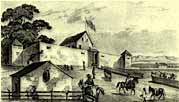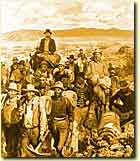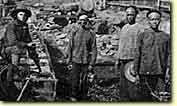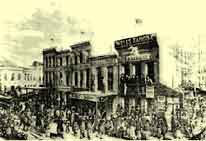In the cities and towns of the East, it seemed almost like wartime. Thousands
of men left their homes and families behind and headed for California. Women
moved in with relatives or fended for themselves. Children wrote letters to
their faraway fathers and waited impatiently for them to come home. It was
1849, and the California Gold Rush had begun.
 James W. Marshall had discovered gold on January 24, 1848. Marshall worked for
John Sutter, a Swiss immigrant who hoped to create an agricultural empire in
California. Sutter owned 39,000 acres of land, on which he raised livestock,
fruits, and vegetables. He built a large fort that was home to a number of
businesses. James W. Marshall had discovered gold on January 24, 1848. Marshall worked for
John Sutter, a Swiss immigrant who hoped to create an agricultural empire in
California. Sutter owned 39,000 acres of land, on which he raised livestock,
fruits, and vegetables. He built a large fort that was home to a number of
businesses.
Marshall was inspecting a ditch at Sutter's saw mill on the South Fork of the
American River when he saw a sparkle beneath the water. He picked up the
glittering particle, half the size of a pea. He was certain that he had found
gold.
In January, 1848, California was largely unsettled. Some 100,000 Native
Americans lived in the foothills of the Sierra Nevada mountains. In small
mission towns and ranches along the coast lived about 10,000 Californios, or
Mexican Californians; 2,000 U.S. citizens; and a few hundred Europeans.
 When Marshall told Sutter that he had discovered gold, Sutter swore him to
secrecy. If word got out, men would rush in from everywhere, and Sutter's
empire would be destroyed. But little by little the news spread. At first only
a trickle of goldseekers found their way to the hills. But that trickle soon
grew. When Marshall told Sutter that he had discovered gold, Sutter swore him to
secrecy. If word got out, men would rush in from everywhere, and Sutter's
empire would be destroyed. But little by little the news spread. At first only
a trickle of goldseekers found their way to the hills. But that trickle soon
grew.
 On May 12, 1948, when word of the discovery reached San Francisco, the town's
male population was about 600. On May 15, only about 200 men remained. By June
1, San Francisco was a ghost town--stores closed, ships abandoned, and houses
deserted. Most of the men had run off to the gold fields. The town's newspapers
even shut down. No one was left to write or read them. On May 12, 1948, when word of the discovery reached San Francisco, the town's
male population was about 600. On May 15, only about 200 men remained. By June
1, San Francisco was a ghost town--stores closed, ships abandoned, and houses
deserted. Most of the men had run off to the gold fields. The town's newspapers
even shut down. No one was left to write or read them.
Gold fever quickly spread. By the end of 1848, prospectors came from as far as
Oregon to the north, the Hawaiian Islands to the west, and Mexico and Chile
from the south. It took almost a year for the news to reach the East. When it
did, a stampede began.
Today it might be hard to understand why men left their homes and loved ones
and traveled thousands of miles to look for gold. But in 1849, a prosperous
farmer might make about two or three hundred dollars a year. A factory worker
made about a dollar for working a twelve hour day. A skilled craftsmen made a
dollar and a half a day.
 In California, gold was free to anyone who could find it. A miner could take
$25 to $35 of gold a day--or even more--out of a riverbed. Stories of miners
becoming rich men in a single day spread like wildfire. Many of these stories
were exaggerations. But some of them were true. In California, gold was free to anyone who could find it. A miner could take
$25 to $35 of gold a day--or even more--out of a riverbed. Stories of miners
becoming rich men in a single day spread like wildfire. Many of these stories
were exaggerations. But some of them were true.
Some men struck it rich, in primitive mining camps with names like Hangtown,
Gouge Eye, and Hell's Delight. The work was back-breaking, but flake by flake,
nugget by nugget, these lucky forty-niners dug up deposits of gold worth
hundreds--or even thousands--of dollars. Most miners were not so lucky. Many of
the best mining sites were quickly claimed, and then picked clean.
Some people in California made money without having to dig for gold. Smart
businesspeople charged miners for supplies and services. A pound of sugar sold
for $2. A pound of coffee for $4. Women in the gold fields could charge $25 for
a cooked meal, or earn $50 a week washing shirts. In 1849, those prices were
sky-high. A successful miner could easily pay them. But many miners could
barely make ends meet.
 As the competition for gold became greater, miners fought over "claims," or
mining rights--sometimes violently. Many Americans from the East blamed their
lack of success on miners from Mexico, Chile, Peru, and China, whom they
considered "foreigners." Miners of Latin American descent--even those who had
lived in California their whole lives--were sometimes violently attacked. Some
were even killed. As the competition for gold became greater, miners fought over "claims," or
mining rights--sometimes violently. Many Americans from the East blamed their
lack of success on miners from Mexico, Chile, Peru, and China, whom they
considered "foreigners." Miners of Latin American descent--even those who had
lived in California their whole lives--were sometimes violently attacked. Some
were even killed.
Eventually, much of the gold that could be mined by hand had been found. Heavy
machinery was needed to dig out the rest. Many miners went home penniless--or
nearly so. John Sutter left California in 1851, heavily in debt. Miners had
invaded his house and trampled his fields. His "empire" was in ruins. James W.
Marshall, the man who first found the gold, had little success as a miner. He
died in poverty in 1885.
 Still, many miners stayed. They started businesses in the boom towns or farmed
the fertile valleys. By 1856, San Francisco had more than 50,000 citizens and
was the largest and most important city in the West. On its streets walked
people from every corner of the world. Still, many miners stayed. They started businesses in the boom towns or farmed
the fertile valleys. By 1856, San Francisco had more than 50,000 citizens and
was the largest and most important city in the West. On its streets walked
people from every corner of the world.
Most California miners never made much money. Yet some did what they set out to
do--they struck it rich, and took home a fortune. They paid off the mortgages
on their farms and started new lives. Sadly, some miners did not go home at
all. They died of diseases like cholera, or from accidents in the gold fields
or on the journey to California. Many of the women and children waiting back
East would never see their loved ones again.
 The Gold Rush transformed not only the lives of people, but California itself.
California's population grew dramatically. Its towns, cities, and businesses
thrived. And almost overnight, it became the most famous American state. People
around the world knew the story of California, the golden land where a fortune
could be dug from the ground. The Gold Rush transformed not only the lives of people, but California itself.
California's population grew dramatically. Its towns, cities, and businesses
thrived. And almost overnight, it became the most famous American state. People
around the world knew the story of California, the golden land where a fortune
could be dug from the ground. |
|

